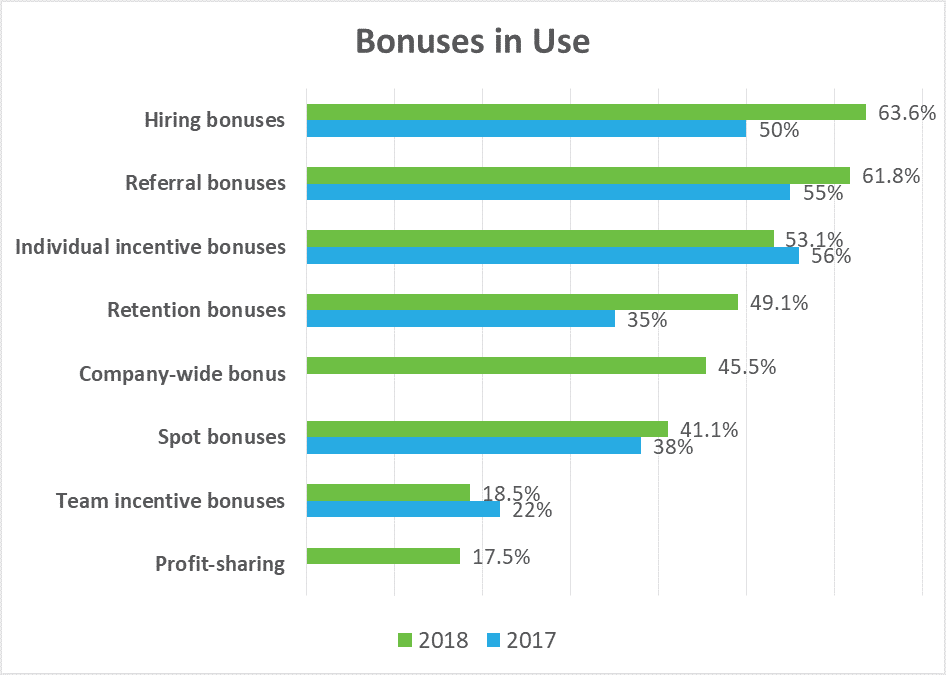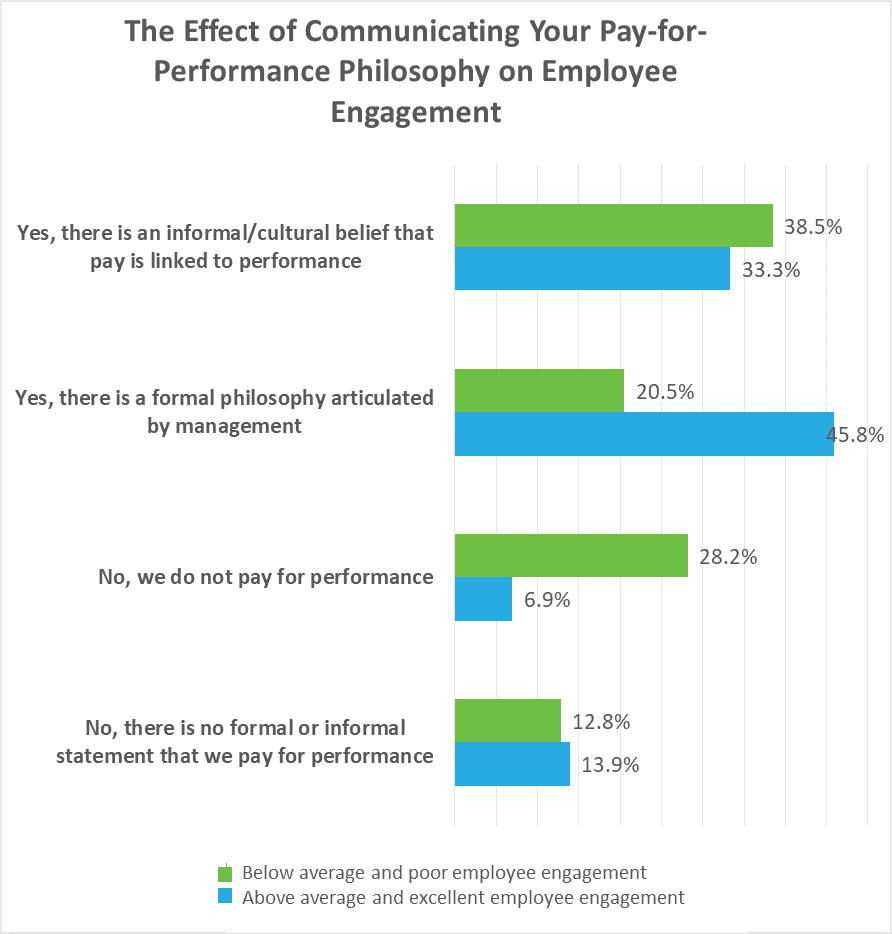77% of Organizations Offering Variable Pay Plans
Written by Connor Harrison
January 8, 2019

In this competitive talent market, organizations with a formal pay-for-performance philosophy are more than twice as likely to have above average or excellent employee engagement, according to our 2018 Pay Practices and Compensation Strategy survey. To this end, 77% of companies in the U.S. are using variable pay programs as part of their total rewards packages, with an additional 9% of companies reporting they definitely will or could adopt a variable pay plan within the next two years.
Variable Pay programs can take many forms, depending on your organization’s budget and overall compensation philosophy. Below we will discuss the limitations of merit increases and several common forms of variable pay we’re seeing this year.
Merit Pay Increases Are Not Enough
Merit pay increases – increases to an employee’s base pay – remain the most commonly used reward vehicle for recognition of top performers. But annual salary increase budgets – which include merit pay increases – remain flat at 3% for the 8th straight year. Additionally, three quarters of participating organizations in the U.S. and Canada are projecting no additional funding for their salary increase budgets again in 2019.
Chris Fusco, the Senior Vice President of Compensation at Salary.com, notes that market pay rates for many jobs have dramatically outpaced median salary increase budgets, meaning that for many employees, opportunities for a higher salary outside your organization are much larger than the opportunities they see within your organization.
While salary increase budgets remain steady, our research demonstrates that budgets for bonuses of all types are on the rise. In this environment, many organizations are maximizing the impact of their budgets by leveraging variable pay programs to keep top recruits’ and top performers’ pay competitive with the market.
What is Variable Pay?
Variable pay types can vary according to the payout period, the employees who are eligible, and the metrics that employees are measured against. In our survey, variable pay types are divided among discretionary bonuses and non-discretionary bonuses.
Discretionary bonuses, such as spot bonuses, are awarded on an ad-hoc basis to employees who demonstrate exceptional performance.
Non-discretionary bonuses, such as individual incentive bonuses, are awarded when employees, teams, or the organization as a whole meets specific, pre-defined goals and objectives.
In participating organizations that do offer variable pay programs, we’re seeing dramatic changes in the proportion of the overall payroll budget they’re committing to these programs. Compared to 2017, the percentage of organizations committing at least 10% of their payroll budget towards non-discretionary bonuses and discretionary bonuses has more than doubled, while the percentage of organizations committing less than 3% of their budget has shrunk substantially.
Our research indicates that organizations with variable pay programs in place have found success in these programs, and are allocating a larger proportion of their budget to them year-over-year.
Variable Pay Types: Performance-Based and Non Performance-Based Bonuses
As organizations look to maximize their variable pay budgets, they can choose from a vast array of different performance- and non performance-based bonus vehicles. Most organizations employ more than one bonus type, with 58.2% reporting that they use between three and five of the eight performance and non-performance bonus types covered by our survey.
Please note: last year’s survey did not account for profit-sharing and company-wide bonuses, but that data is available for 2018.
Individual, Team, and Company-Wide Incentive Bonuses
Individual incentive bonuses were the most popular variable pay type in 2018, leveraged by 56% of organizations in our survey. These bonuses have increased in popularity since last year, as more organizations look to reward top performers for their individual, measurable contributions to the business. Team incentive bonuses, on the other hand, ranked second-to-last among all bonuses in 2018, and have decreased in popularity in recent years. This may be because companies are moving away from small-group incentives, or it could be because organizations are now rolling team-level performance into calculations that determine individual-level bonus payouts.
Company-wide bonuses, which we did not measure in 2017, may also have replaced team bonuses. In designing their variable pay programs, almost 50% of the organizations in our survey are now leveraging company-wide bonuses to drive collaboration and incentivize behaviors that align with common organizational goals.
Companies that reported the highest levels of employee engagement in our survey were the most likely to also report that they use both individual incentives and company-wide bonuses, indicating that an effective balance of bonus programs may be the most effective motivating factor.
Hiring and Referral Bonuses
Hiring and referral bonuses – the two non-performance bonus types on this list – were among the most widely used bonus types in our survey. In today’s talent market, where top talent is hard to come by, it is perhaps no surprise that organizations are going above and beyond to incentivize employees to join the organization and to refer their friends and colleagues to join as well.
Hiring bonuses help secure top talent outright by leveraging a one-time payment to increase the compensation package offered during the recruiting process. These bonuses are especially helpful for securing talent to fill hot jobs – new or emerging jobs that command a premium in price due to their specialized nature, or existing jobs where the demand for talent far outstrips the supply.
Similarly, through referral bonuses, companies are extending the hiring initiative to dependable staff by having current employees help source new talent for the organization. Additionally, referral bonuses save HR work, since existing staff are effectively aiding in the search for high-caliber candidates, which leads to better output and higher retention of those existing employees. And, by encouraging folks to bring great people into the organizations, companies may even be using this referral bonus as an incentive to work on company culture.
Despite their popularity, only 16.5% of the companies in our survey that use referral bonuses reported above average employee engagement. We expected organizations with high engagement to be particularly successful with referral bonuses: happy and highly engaged employees are more likely to want to find other talented people and friends who would enjoy working in a similar environment, and would may be more eager to share opportunities and reap the reward of the referral bonus. Instead, it would seem that many organizations offer referral bonuses, but this reward vehicle is more indicative of an HR initiative, rather than an especially engaged employee base.
Retention Bonuses
The percentage of organizations that employ retention bonuses, which are designed to reward tenured employees for their service, has risen by more than 14 points since last year. Though typically awarded for 5 or more years of service, today’s retention bonuses are appearing earlier and more frequently in the employee life cycle, in order to maximize their effects.
How Do Pay-For-Performance Programs Drive Engagement?
A pay-for-performance philosophy contributes to employee engagement by clearly tying employee or company achievement of performance goals to tangible financial rewards. These programs also enable employees to see a clear connection between the work they do everyday and the success of the company as a whole. If awarded more than once per year, they can also facilitate more frequent conversations about individual and company performance, allowing managers to provide critical feedback outside the annual review process.
Formal vs. Informal Pay-for-Performance Philosophies
Among the 75% of organizations that said they had a pay-for-performance philosophy as part of their overall compensation philosophy, there is a significant distinction to make: organizations with a formal pay philosophy were more likely to view themselves as above average or excellent for employee engagement (45.8%) versus organizations with an informal/cultural belief in pay for performance (33.8%).
Without a clear, formalized strategy communicated by the organization, your pay-for-performance plan can be left open to interpretation, negating the potential positive effects of clearly linking high performance with financial rewards. Furthermore, if different managers use entirely different metrics and measurements to calculate payouts across teams, employees may be uncertain of the true policy or hear inconsistent theories on what it is. When implementing pay-for-performance programs, make sure to formalize and communicate your approach to your employees to demonstrate your commitment to this philosophy and maximize the potential engagement you get out of it.


Download our white paper to further understand how organizations across the country are using market data, internal analytics, and strategic communication to establish an equitable pay structure.
Insights You Need to Get It Right












